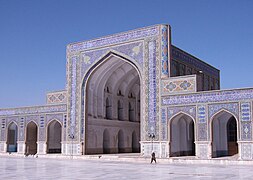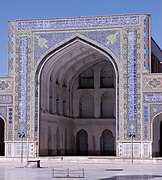Great Mosque of Herat
| Great Mosque of Herat | |
|---|---|

|
|
| Coordinates : 34 ° 20 ′ 35 ″ N , 62 ° 11 ′ 45 ″ E | |
| place | Herat |
| Laying of the foundation stone | 1404 AD |
| opening | 1446 AD |
| Direction / grouping | Sunnism |
| Architectural information | |
| architect | Jalal al-Din Firuzshah |
| Details | |
| Minarets | 8th |
The Great Mosque of Herat ( Arabic مسجد الجامع هرات Masjid al-Jāmi 'Herat ), and Masjid-i Jāmi' ( Persian مسجد جامع) or known "Jami Masjid of Herat", is a mosque in the city of Herat in the same province in Northwest Afghanistan . It was built by the Ghurids under the rule of Sultan Ghiyath al-Din Muhammad Ghori , who had the foundations built in 1200 AD, and was later expanded by various rulers - including the Timurids , Safavids , Mughals and then the Uzbeks , of which all supported the construction project. Though many of the glazed bricks have been replaced over the centuries, the Friday Mosque 's current appearance dates from the late 15th century.
Apart from numerous small mosques for daily prayer, most congregations in the Islamic world have a larger mosque for Friday prayer followed by a sermon. The Jama Masjid was not always the largest mosque in the city; a much larger complex was the mosque and madressa of Gawharshad , also built by the Timurids, which stood in the north of Herat. However, these monuments were blown up by officers of the British Indian Army in 1885 to prevent Russia from using them as a fortress to invade India .
history
The Masjid-i Jami of Herat, the city's first Friday mosque, was built on the site of two smaller Zoroastrian fire temples that had been destroyed by earthquakes and fire. In 1200 the Ghurid leader Ghiyas al-Din Ghori started construction, after his death the project was continued by his brother and successor Muhammad von Ghor. This is confirmed not only by an inscription at the eastern entrance, which was discovered in 1964 during restoration work, but also by the Timurid historian Khwandamir (approx. 1475 to approx. 1535) in his Khulasat al-Akhbar .
Timurids
In 1221 Genghis Khan took the province and like a large part of the city of Herat, the then still small mosque fell victim to the enemy. It was not until 1245 that attempts were made to rebuild the building under Sham al-Din Kart, but no actual construction took place until 1306. A devastating earthquake in 1364 left the mosque almost completely destroyed, although a few attempts were made to restore it. After 1397 the ruler at that time put the focus of the growth of Herat back on the northern part; This and the construction of a new Friday mosque in Gawhar Shads Musalla meant the end of royal support for the Masjid-i Jami . The destroyed house of prayer was replaced with a completely new building and associated gardens, all at the request of Jallal al-Din Firuzshan, one of the most prominent emirs under Shah Ruch (1405–1444). The decorations alone took more than five years to complete, as the emir hired workers from all over the empire. The mosque was later renovated again under the Mughal Empire when Prince Khurram ( Shah Jahan ) fought for control of the region against Uzbek clans.
Modern developments
Little remains of the medieval mosque; much of the building was in ruins after the Anglo-Afghan wars . A project from 1945 prompted the reconstruction of the walls and rooms, the extension of the northeast section from about 101 to 121 meters and the replacement of expensive materials from the medieval Timurid and Mughal empires with locally available, cheap fabrics. Overall, the numerous reconstructions and restorations have left little of the original mosque. Nevertheless, the Ghuridic entrance to the south of the main entrance with the inscription remained.
In 2012, fifty Afghan traders pledged funds to renovate the Great Mosque.
description
The Great Mosque is laid out in the traditional, rectangular Iwan pattern, with three walls and a huge inner courtyard. Part of the original ornamentation has remained in the central section, but much has been replaced.
gallery
Individual evidence
- ↑ Great Mosque of Herat. In: Archnet.org. October 3, 2012, accessed November 10, 2018 .
- ↑ Nadia Eboo Jamal: Surviving the Mongols: Nizārī Quhistānī and the Continuity of Ismaili Tradition in Persia . Tauris, London, ISBN 978-1-86064-876-2 , pp. 70 .
- ↑ UNESCO World Heritage Center: City of Herat - UNESCO World Heritage Center. Retrieved November 10, 2018 .
- ↑ Historical Herat Mosque Built over Ancient Zoroastrian Temples Being (...) - The Gazette of Central Asia. Retrieved November 10, 2018 .










